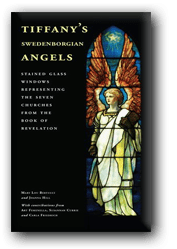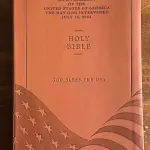 On Monday I received my copy of Tiffany’s Swedenborgian Angels by Mary Lou Bertucci and Joanna Hill, currently featured on the Patheos Book Club. I’ve been reading it in bits and pieces over the last few days. It’s not a long book, but it’s one that invites pausing and reflecting.
On Monday I received my copy of Tiffany’s Swedenborgian Angels by Mary Lou Bertucci and Joanna Hill, currently featured on the Patheos Book Club. I’ve been reading it in bits and pieces over the last few days. It’s not a long book, but it’s one that invites pausing and reflecting.
First and foremost: this is a beautiful book. Its tall, narrow dimensions make the perfect frame for the angel windows, a set of seven stained-glass windows commissioned in 1902 by the New Church in Glendale, Ohio, and designed by Louis Comfort Tiffany, depicting the seven angels of the churches in Asia from the Book of Revelation. And Douglas Lockard’s photography of the windows themselves – backlit against solid black backgrounds – brings out the luminescence of the stained glass in way that makes the pictures almost seem to glow.
I expected the book to focus more on the story of the windows – how they were commissioned, the Swedenborgian input into their design, the story of their recovery after years of neglect. The book does touch on those things in the introduction and in an afterword, but that’s not the main focus of the book – the primary purpose, it seems, is to encourage contemplation on the meaning of the windows, with each chapter exploring one of the letters to the churches from second and third chapters of Revelation. There’s a good balance between historical / scholarly interpretation, and explanations of the spiritual sense of the stories as described by Swedenborg in Apocalypse Revealed (or Revelation Unveiled in the forthcoming New Century translation).
The chapters explore some of the possible connections between Tiffany’s portrayal of the angels and spiritual sense as described by Swedenborg in Apocalypse Revealed, but the historian in me wishes there were more to go on. What were Tiffany’s own religious beliefs? Did he read Swedenborg? Did the church in Glendale give him particular instructions for the different angels, or did they leave it all up to him? Apparently there’s not a lot to go on: according to the introduction,
It is not known whether any ‘directions’ – perhaps better thought of as suggestions, given Tiffany’s supreme confidence in his art – were sent to Tiffany for the composition of these windows; certainly none has been found in existing records. However, it is not a stretch to think that the commissioning Glendale church would have suggested appropriate presentation based on the writings of the Swedish seer. (p. 9)
For the most part, this doesn’t detract from the book; but when the authors start to analyze the spiritual sense of the colors of the angels’ clothes (e.g. “the red robe under the white drape represents love” in the angel of Smyrna on page 30), I can’t help thinking that they may be trying too hard to look for deeper meaning in Tiffany’s artistic decisions than was really there when he designed the windows.
This opens up a discussion that is somewhat tangential to the book itself, although does have some bearing on it: to me, that search for a spiritual sense in Tiffany’s art seems a little like creating meaning where there wasn’t anything deeper intended; but I realize that those who haven’t embraced Swedenborgianism may feel precisely the same way about the spiritual sense given for the letters to the angels. To those who haven’t thoroughly immersed themselves in the teachings about correspondences, and who haven’t seen those teachings applied consistently across several stories in the Bible, it can seem very much like the spiritual sense could be made up on a whim.
I remember reading somewhere – and I wish I could find the quote again – someone describe Swedenborg’s Biblical exegesis as the kind of creative interpretation you’d expect to find in an undergraduate English class. This symbol represents the main character’s love, that symbol represents his wisdom, etc. And, as with that kind of undergraduate literary exegesis, it seems like with this method of looking for an “internal sense” a person could concoct just about any conclusions he wanted to come to.
When you first start to read some of the exegesis in the Writings it really can come across that way. And even being raised in the New Church, I know that I used to feel like rather than looking for an internal sense within the Bible, I was making one up. But as I slowly worked my way through Arcana Coelestia and Apocalypse Revealed, I started to get a sense of the way the internal sense works within the literal sense. When you start to see the big picture – and see the way that correspondences are applied consistently – it does become clearer that they’re really a way of seeing something that’s already there, rather than inventing something.
A few other points about this I want to make before getting back to the book. First, as a New Churchman I believe that the spiritual sense as given in Swedenborg’s Writings is revealed by God. And so in that sense it’s different from an undergraduate saying, “I think this represents that.” Secondly, though, Swedenborg does not usually ask his readers to take on faith that one thing represents another. He usually brings together passages from all over the Bible that illustrate whatever he is saying about the internal sense. For example, rather than just saying, “A rock represents truth,” he brings together passages that taken together illustrate this point – that Jesus said, “On this rock I will found my church,” passages where the God is called a rock, etc. Third, Swedenborg writes that all the essential doctrines of the New Church are drawn from the literal sense of the Word. In fact, the spiritual sense “illustrates and confirms” doctrine, but it does not establish doctrine. True, a Swedenborgian does not take every passage in the Bible literally – but neither does any other Christian. And Swedenborg writes that the way to understand the truth in the Bible is not to dismiss it, and not to simply say, “this has a deeper meaning, so I can ignore the literal meaning,” but to compare different passages in the Bible and see from them what kind of deeper truth is being conveyed. For example, Genesis 22:1 says, “God tempted Abraham” – but James 1:13 says, “God cannot be tempted by evil, nor does He Himself tempt anyone.” And so when Genesis 22 says that God tempted Abraham, that may be true on one level, but on a deeper level something else must be going on. That idea of a deeper level isn’t artificial – it comes from trying to reconcile another teaching that is clearly and literally stated. The appearance is that God tempts; the reality is that God allows a person to be drawn into temptation by his own evils, for the sake of strengthening that person’s faith.
Anyway, back to the book. As I say, someone with my natural skepticism might find themselves distracted by some of the assertions about the spiritual meaning of these angels. But those sections of the book are not intending to be about Tiffany’s motivation; they’re suggestions of ideas to meditate on while taking in the beauty of the windows. And as that, the book provides just as much as is needed: enough substantial thoughts to distinguish each angel from the others, but not so much as to be overwhelming. The prayers that conclude each chapter are particularly well-written, capturing the spirit of each angel in only a few words.
In the end, I found myself wanting to turn back to Apocalypse Revealed itself to see the details of what each angel meant, a fuller picture of the internal sense. That’s not a criticism of the book; in fact, to my mind, anything that inspires me to go back to the source is doing something right. And as a tool for reflection on those different states represented by the seven churches, this book – especially in the pictures of the windows themselves – serves admirably. It really is a beautiful book.











